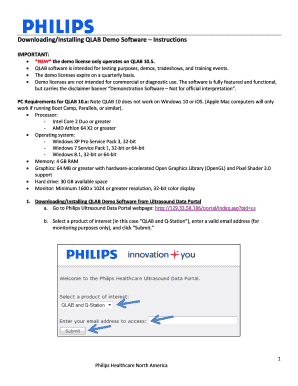

However, LV volumes may be somewhat more underestimated with the current QLAB software version. Clinical Applications Are Available On The.
PHILIPS QLAB MANUAL MANUAL
RT3DE with TomTec or QLAB software analysis provides accurate LV-EF assessment in cardiomyopathic patients with distorted LV geometry and adequate 2D image quality. Philips EPIQ 7 Manual Online: clinical/analysis applications, Qlab Advanced Quantification Software Options. The analysis time was shorter with QLAB (4 +/- 2 minutes vs. Interobserver variability was 6.4 +/- 7.8% vs. Both programs accurately calculated LV ejection fraction (LV-EF) without a bias. B-mode ultrasound (Philips HDX7E, Phillips, UK) images of the common carotid artery using both manual and semiautomated methods (QLAB, Phillips, UK). LV-EDV and LV-ESV were significantly more underestimated with QLAB software. Also, an underestimated LV end-systolic volume (LV-ESV) for both TomTec (-4.8 +/- 9.9 mL) and QLAB (-8.5 +/- 14.2 mL) was found. Bland-Altman analysis revealed an underestimated LV end-diastolic volume (LV-EDV) for both TomTec (-9.4 +/- 8.7 mL) and QLAB (-16.4 +/- 13.1 ml). Off-line left ventricular (LV) volume analysis was performed with QLAB V4.2 (semiautomated border detection with biplane projections) and TomTec 4D LV analysis V2.0 (primarily manual tracking with triplane projections and semiautomated border detection).Įxcellent correlations (R(2) > 0.98) were found between MRI and RT3DE. This can be particularly helpful in comparing changes in cardiac and vascular anomalies, further documenting changes after interventional procedures, or evaluating foetal development.To compare the interobserver variability and accuracy of two different real time three-dimensional echocardiography (RT3DE) analyzing programs.įorty-one patients (mean age 56 +/- 11 years, 28 men) in sinus rhythm with a cardiomyopathy and adequate 2D image quality underwent RT3DE and magnetic resonance imaging (MRI) within one day. Live compare allows the clinician to compare a previous exam side-by-side with an active exam in order to see immediately changes in structure or blood flow. ‘Images and Cineloops can receive further investigation by manipulating the original image to see new detail.
PHILIPS QLAB MANUAL FULL
A broad suite of configurable patient reports and exam storage options, such as DVD-CD-R/RW, USB drive, and full DICOM capabilities, provide efficient patient data management and colleague or specialist consulting.’Īctive native data allows clinicians to manipulate examination parameters and image settings even after a patient has left. ‘Tissue Specific Imaging presets and iSCAN one button image optimisation can quickly provide clear images with little to no adjustment. ‘New Microfine EX focusing provides sharper images and improved tissue uniformity throughout the depth of field through application of new dynamic receive lens tuning with five times more focal points than previous generation systems,’ Philips explained. The HD15 includes Philips QLAB quantification software, XRES image processing and PureWave transducer crystal technology. Features such as contrast enhanced ultrasound and PureWave transducer technology also allow real-time guidance and evaluation of minimally invasive treatments. Welcome to QLab 5 This manual is a comprehensive, in-depth reference manual intended to cover every aspect and detail of QLab, and provide adjacent information where relevant. Along with workflow improvements, the HD15 capabilities include general imaging, cardiac, vascular and obstetrics/gynaecology applications. Check out the change log to see what’s new in this release. ‘The system may be used as a primary system for some users, particularly those in emerging markets who require a feature-rich system but may not need all of the features of a high-end ultrasound solution,’ Philips added. ‘The HD15 brings capabilities that assure user simplicity and productivity to more clinicians in a variety of clinical settings,’ explained Anne LeGrand, senior vice president, Ultrasound, for Philips Healthcare.


 0 kommentar(er)
0 kommentar(er)
